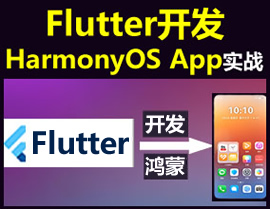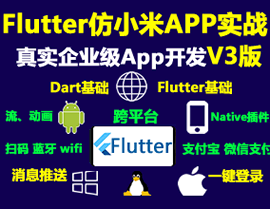Flutter配置管理或集成插件cmdb的使用
Flutter配置管理或集成插件cmdb的使用
简介
cmdb 是一个用于从 Firebase 实时数据库存储和获取信息的 Flutter 插件。通过该插件,您可以轻松地管理配置数据,并与 Firebase 实时数据库进行交互。
开始使用
步骤 1:创建 Firebase 项目
- 登录到 Firebase 控制台 并创建一个新的项目。
- 在实时数据库部分,设置
.read和.write的规则为true(开发环境)以便允许读写操作。
步骤 2:获取 Firebase 数据库 URL
在 Firebase 实时数据库的设置页面中,复制数据库的 URL(例如:https://cmdatabase-xxxxx-default-rtdb.firebaseio.com/)。
步骤 3:添加依赖项
在项目的 pubspec.yaml 文件中添加 cmdb 插件作为依赖项:
dependencies:
cmdb: ^版本号然后运行以下命令以更新依赖项:
flutter pub get示例代码
以下是完整的示例代码,展示了如何使用 cmdb 插件来管理用户数据。
主文件 main.dart
import 'package:flutter/material.dart';
import 'package:cmdb/cmdb.dart'; // 导入 cmdb 插件
void main() {
runApp(MyApp());
}
class MyApp extends StatelessWidget {
// 应用入口
[@override](/user/override)
Widget build(BuildContext context) {
return MaterialApp(
title: 'Cmdb 示例',
theme: ThemeData(
primarySwatch: Colors.blue,
),
home: CmdbExample(title: 'Cmdb 示例'),
);
}
}
class CmdbExample extends StatefulWidget {
CmdbExample({Key? key, required this.title}) : super(key: key);
final String title;
[@override](/user/override)
_CmdbExampleState createState() => _CmdbExampleState();
}
class _CmdbExampleState extends State<CmdbExample> {
CMDB database = CMDB(); // 初始化 cmdb 实例
Map<String, dynamic> _users = {}; // 存储从 Firebase 获取的用户数据
int _counter = 1; // 用于生成唯一用户名和密码
[@override](/user/override)
void initState() {
super.initState();
// 初始化 cmdb,只需在主函数中调用一次
database.initialize(
'https://cmdatabase-xxxxx-default-rtdb.firebaseio.com/');
}
// 获取所有用户数据
void getUsers() {
String path = 'Users/';
database.get<Map<String, dynamic>>(path).then((value) {
if (value != null) {
setState(() {
_users = value;
});
}
});
}
// 创建带唯一键值的用户
void createUserWithUniqueKey(String username, String password) {
String path = 'Users';
database.create(path, {'username': username, 'password': password}).then(
(response) {
if (response != null) _counter++;
},
);
}
// 创建指定用户名的用户
void createUser(String username, String password) {
String path = 'Users/$username';
database.update(path, {'username': username, 'password': password}).then(
(response) {
if (response) _counter++;
},
);
}
// 显示用户列表
Widget showUserList() {
return ListView.separated(
shrinkWrap: true,
physics: ScrollPhysics(),
itemCount: _users.length,
itemBuilder: (BuildContext context, int index) {
String key = _users.keys.elementAt(index);
return Center(
child: Column(
children: [
Text('Key: $key'),
Text("Username: ${_users[key]!['username']}"),
Text("Password: ${_users[key]!['password']}"),
],
),
);
},
separatorBuilder: (BuildContext context, int index) => const Divider(),
);
}
[@override](/user/override)
Widget build(BuildContext context) {
return Scaffold(
appBar: AppBar(
title: Text(widget.title),
),
body: SingleChildScrollView(
child: Column(
children: [
ElevatedButton(
onPressed: () {
createUserWithUniqueKey('username $_counter', 'password $_counter');
},
child: Text('创建带唯一键值的用户'),
),
ElevatedButton(
onPressed: () {
createUser('username $_counter', 'password $_counter');
},
child: Text('创建指定用户名的用户'),
),
ElevatedButton(
onPressed: () {
getUsers();
},
child: Text('获取用户列表'),
),
showUserList(),
],
),
),
);
}
}更多关于Flutter配置管理或集成插件cmdb的使用的实战系列教程也可以访问 https://www.itying.com/category-92-b0.html
在Flutter中,配置管理是一个重要的部分,尤其是在开发过程中需要管理不同的环境(如开发环境、测试环境、生产环境)时。Flutter本身并没有内置的配置管理工具,但可以通过一些第三方插件或手动管理来实现。至于“cmdb”插件,目前并没有一个广泛使用的Flutter插件直接叫这个名字,但可能是指某种配置管理或数据库管理的插件。以下是一些常见的Flutter配置管理方法和相关插件:
1. 手动管理配置
手动管理配置是最简单的方式,通过创建不同的配置文件来管理不同环境的配置。
// config.dart
class Config {
static const String apiUrl = 'https://api.example.com';
static const String apiKey = 'your_api_key';
}
// config_dev.dart
class ConfigDev {
static const String apiUrl = 'https://dev.api.example.com';
static const String apiKey = 'your_dev_api_key';
}
// main.dart
void main() {
const isProduction = bool.fromEnvironment('dart.vm.product');
final config = isProduction ? Config() : ConfigDev();
runApp(MyApp(config));
}2. 使用 flutter_dotenv 插件
flutter_dotenv 是一个常用的插件,用于从 .env 文件中加载配置。
安装插件
dependencies:
flutter_dotenv: ^5.0.0使用
- 创建
.env文件
API_URL=https://api.example.com
API_KEY=your_api_key- 在
pubspec.yaml中配置
flutter:
assets:
- .env- 在代码中使用
import 'package:flutter_dotenv/flutter_dotenv.dart';
void main() async {
await dotenv.load(fileName: ".env");
final apiUrl = dotenv.env['API_URL'];
final apiKey = dotenv.env['API_KEY'];
runApp(MyApp(apiUrl, apiKey));
}3. 使用 config 插件
config 插件是一个专门用于管理不同环境配置的插件。
安装插件
dependencies:
config: ^1.0.0使用
- 创建配置文件
# config/default.yaml
apiUrl: https://api.example.com
apiKey: your_api_key
# config/dev.yaml
apiUrl: https://dev.api.example.com
apiKey: your_dev_api_key- 在代码中使用
import 'package:config/config.dart';
void main() {
final config = Config('config/default.yaml');
final apiUrl = config.get<String>('apiUrl');
final apiKey = config.get<String>('apiKey');
runApp(MyApp(apiUrl, apiKey));
}4. 使用 firebase_remote_config 插件
如果需要从远程服务器获取配置,可以使用 firebase_remote_config。
安装插件
dependencies:
firebase_core: ^1.0.0
firebase_remote_config: ^0.10.0使用
import 'package:firebase_core/firebase_core.dart';
import 'package:firebase_remote_config/firebase_remote_config.dart';
void main() async {
WidgetsFlutterBinding.ensureInitialized();
await Firebase.initializeApp();
final remoteConfig = FirebaseRemoteConfig.instance;
await remoteConfig.fetchAndActivate();
final apiUrl = remoteConfig.getString('api_url');
final apiKey = remoteConfig.getString('api_key');
runApp(MyApp(apiUrl, apiKey));
}5. 使用 shared_preferences 插件
如果需要持久化存储配置,可以使用 shared_preferences。
安装插件
dependencies:
shared_preferences: ^2.0.0使用
import 'package:shared_preferences/shared_preferences.dart';
void main() async {
final prefs = await SharedPreferences.getInstance();
final apiUrl = prefs.getString('api_url') ?? 'https://api.example.com';
final apiKey = prefs.getString('api_key') ?? 'your_api_key';
runApp(MyApp(apiUrl, apiKey));
}






